
The Albatros C.III was a twin-seat general-purpose biplane designed and produced by the German aircraft manufacturer Albatros Flugzeugwerke. It was produced in greater numbers than any other C-type aircraft by Albatros as well as being the company's most-produced twin-seat aircraft.

The Albatros C.I,, was a twin-seat general-purpose biplanes designed and produced by the German aircraft manufacturer Albatros Flugzeugwerke. It was the first of the successful C-series aircraft operated by the Luftstreitkräfte.

The Albatros B.II, was an unarmed two-seat reconnaissance biplane designed and produced by the German aircraft manufacturer Albatros Flugzeugwerke. It was the aircraft that brought Albatros Flugzeugwerke to the world's attention.
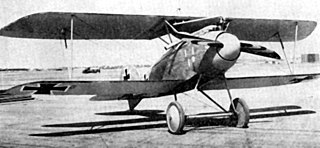
The Albatros D.III was a biplane fighter aircraft used by the Imperial German Army Air Service (Luftstreitkräfte) during World War I. A modified licensed version was built by Oeffag for the Austro-Hungarian Air Service (Luftfahrtruppen). The D.III was flown by many top German aces, including Wilhelm Frankl, Erich Löwenhardt, Manfred von Richthofen, Karl Emil Schäfer, Ernst Udet, and Kurt Wolff, and Austro-Hungarians like Godwin von Brumowski. It was the preeminent fighter during the period of German aerial dominance known as "Bloody April" 1917.
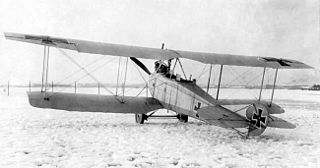
The Aviatik C.I was an observation aircraft which came into service during World War I in April 1915. It was a development of the Aviatik B.I and B.II models, being one of first aircraft of the new German C class of armed biplanes. In the C.I the observer sat in front of the pilot, with a machine-gun clipped on a sliding mounting fitted on a rail at either side of the cockpit. It gave the crew the means to attack enemy aircraft. The positions of the pilot and observer were reversed in last series of 50, ordered in 1917 solely for trainer purpose. There was only one aircraft built of refined C.Ia version in May 1916, with armament still in a forward cab, serving as a prototype for C.III. Later models of the plane included the Aviatik C.II and the C.III, which had more powerful engines. The C.III was produced in large numbers.

The Albatros D.V is a fighter aircraft of the German aircraft manufacturer Albatros Flugzeugwerke. It was the final development of the Albatros D.I family and the last Albatros fighter to see operational service with the Luftstreitkräfte during the First World War.

The Bristol Scout was a single-seat rotary-engined biplane originally designed as a racing aircraft. Like similar fast, light aircraft of the period it was used by the RNAS and the RFC as a "scout", or fast reconnaissance type. It was one of the first single-seaters to be used as a fighter aircraft, although it was not possible to fit it with an effective forward-firing armament until the first British-designed gun synchronizers became available later in 1916, by which time the Scout was obsolescent. Single-seat fighters continued to be called "scouts" in British usage into the early 1920s.

The Pfalz D.III was a fighter aircraft used by the Luftstreitkräfte during the First World War. The D.III was the first major original design from Pfalz Flugzeugwerke. Though generally considered inferior to contemporary Albatros and Fokker fighters, the D.III was widely used by the Jagdstaffeln from late 1917 to mid-1918. It continued to serve as a training aircraft until the end of the war.

The Albatros W.4 was a German floatplane derivative of the Albatros D.I fighter with new wing and tail surfaces of greater span than the D.I. One hundred eighteen examples were built between June 1916 and December 1917. The aircraft operated in the North Sea and Baltic theatres and later served as training aircraft.
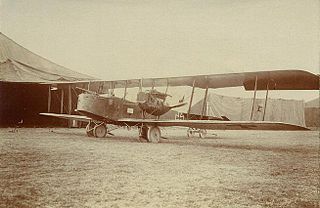
The Friedrichshafen G.III was a heavy bomber designed and manufactured by Flugzeugbau Friedrichshafen. They were used by the German Imperial Air Service during World War I for tactical and limited strategic bombing operations. After the end of the war a number of Friedrichshafen bombers were converted into transport aircraft while a small number also saw service as dedicated airliners.

The AGO C.IV was a German biplane reconnaissance aircraft designed and produced by the German aircraft manufacturer AGO Flugzeugwerke. It was active with the Luftstreitkräfte during the latter half of the First World War.
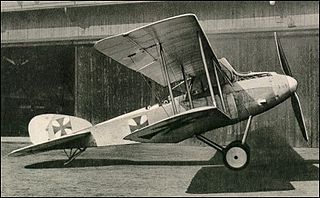
The Albatros C.V was a military reconnaissance aircraft designed and produced by the German aircraft manufacturer Albatros Flugzeugwerke.

The Albatros C.VII was a military reconnaissance aircraft designed and produced by the German aircraft manufacturer Albatros Flugzeugwerke. It was a revised and re-engined development of the Albatros C.V, which had proved disappointing in service.

The Albatros C.X was a military reconnaissance aircraft designed and produced by the German aircraft manufacturer Albatros Flugzeugwerke.

The Hannover CL.III was a German military aircraft of World War I. It was a two-seat multi-role aircraft, primarily used as a ground attack machine. Like the other Hannover "light-C-class", or "CL" designated aircraft designed by Hermann Dorner, it included an unusual biplane tail, allowing for a greater firing arc for the tail gunner. Until the introduction of the aircraft, such tails had only been used on larger aircraft.

The Junkers J.I was a German "J-class" armored sesquiplane of World War I, developed for low-level ground attack, observation and army cooperation. It is especially noteworthy as being the first all-metal aircraft to enter mass production; the aircraft's metal construction and heavy armour was an effective shield against small arms fire over the battlefield.

The Hansa-Brandenburg D.I, also known as the KD was a German fighter aircraft of World War I. Despite poor handling characteristics it was put into service by Austria-Hungary, where some aircraft served until the end of the war.
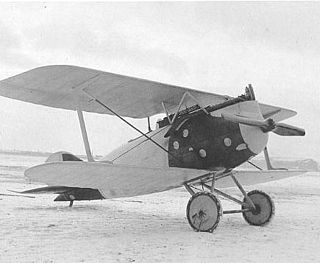
The Rumpler D.I was a fighter-reconnaissance aircraft produced in Germany at the end of World War I. It was a conventional single-bay biplane with wings of unequal span braced by I-struts. It featured an open cockpit and a fixed, tailskid undercarriage. The upper wing was fitted with aerodynamically balanced ailerons and fuselage had an oval cross-section.

The Siemens-Schuckert R.II was a prototype bomber aircraft built in Germany during World War I. It was one of six aircraft based on the Siemens-Schuckert R.I that were originally intended to be identical, but which each developed in a different direction and were designated as different aircraft types by the German Inspectorate of Flying Troops. Although the R.II was the first of the batch to be completed, it was the last accepted into military service, and then only as a trainer.

The Zeppelin-Lindau Rs.II was a biplane flying boat, designed by Claudius Dornier as a follow-on to his Zeppelin-Lindau Rs.I and built during 1914–1915 on the German side of Lake Constance. Initially this aircraft was powered by three engines mounted inside the hull driving three pusher propellers via gearboxes and shafts. The later version was powered by four engines in two push-pull nacelles mounted between the wings.





















